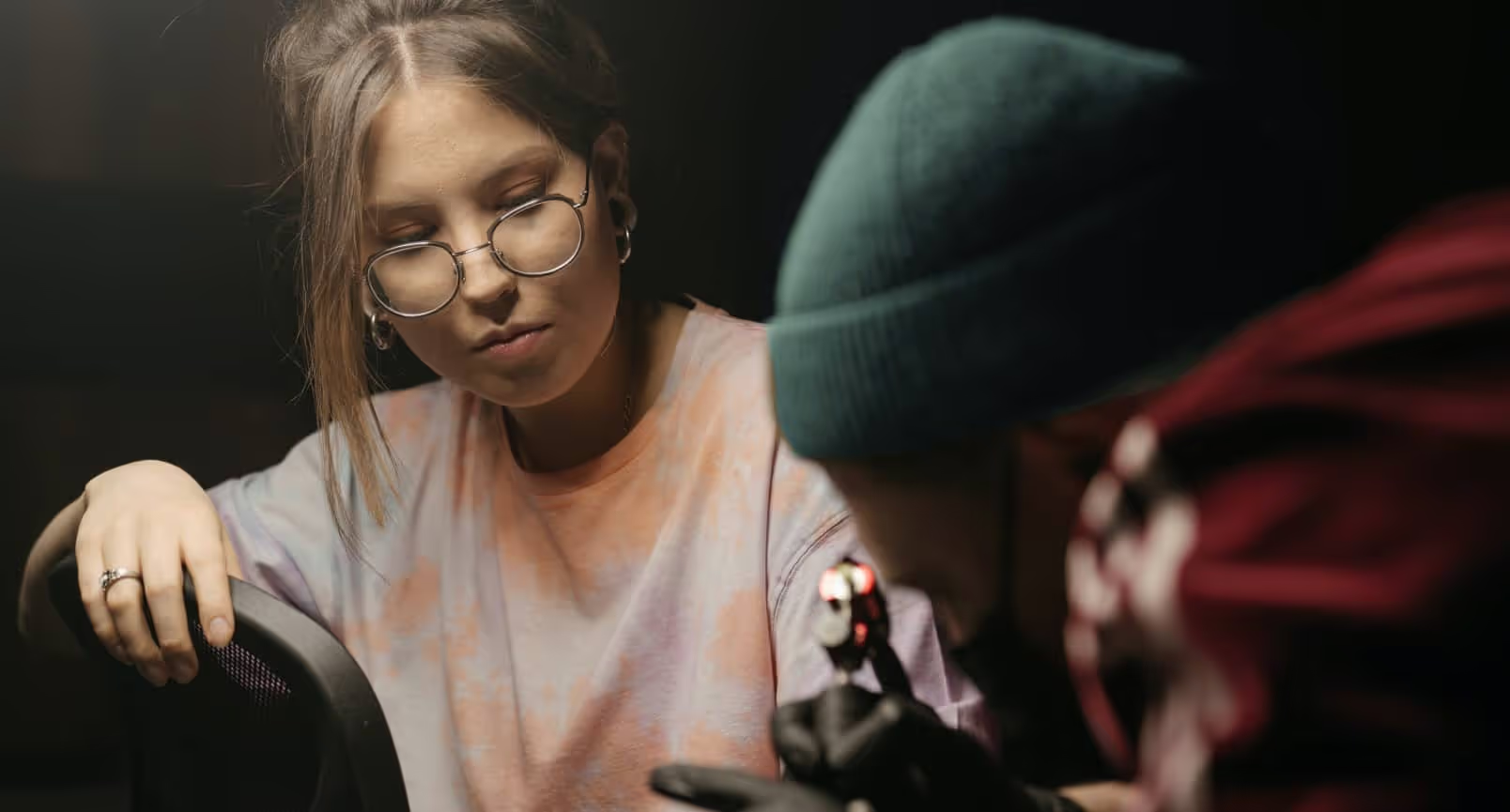The Hidden Dangers of Second Skin in Tattoo Aftercare
Discover hidden risks of second skin tattoo aftercare, including allergies, infections, and safer alternatives for healing.
.png)

most popular areas for a tattoo
Lorem ipsum dolor sit amet, consectetur adipiscing elit lobortis arcu enim urna adipiscing praesent velit viverra sit semper lorem eu cursus vel hendrerit elementum morbi curabitur etiam nibh justo, lorem aliquet donec sed sit mi dignissim at ante massa mattis.
- Neque sodales ut etiam sit amet nisl purus non tellus orci ac auctor
- Adipiscing elit ut aliquam purus sit amet viverra suspendisse potent
- Mauris commodo quis imperdiet massa tincidunt nunc pulvinar
- Excepteur sint occaecat cupidatat non proident sunt in culpa qui officia
what to know before getting tattooed
Vitae congue eu consequat ac felis placerat vestibulum lectus mauris ultrices cursus sit amet dictum sit amet justo donec enim diam porttitor lacus luctus accumsan tortor posuere praesent tristique magna sit amet purus gravida quis blandit turpis.

sensitivity is different on each skin
At risus viverra adipiscing at in tellus integer feugiat nisl pretium fusce id velit ut tortor sagittis orci a scelerisque purus semper eget at lectus urna duis convallis. porta nibh venenatis cras sed felis eget neque laoreet suspendisse interdum consectetur libero id faucibus nisl donec pretium vulputate sapien nec sagittis aliquam nunc lobortis mattis aliquam faucibus purus in.
- Neque sodales ut etiam sit amet nisl purus non tellus orci ac auctor
- Adipiscing elit ut aliquam purus sit amet viverra suspendisse potenti
- Mauris commodo quis imperdiet massa tincidunt nunc pulvinar
- Adipiscing elit ut aliquam purus sit amet viverra suspendisse potenti
prevent allergies and request natural ink
Nisi quis eleifend quam adipiscing vitae aliquet bibendum enim facilisis gravida neque. Velit euismod in pellentesque massa placerat volutpat lacus laoreet non curabitur gravida odio aenean sed adipiscing diam donec adipiscing tristique risus. amet est placerat in egestas erat imperdiet sed euismod nisi.
“Nisi quis eleifend quam adipiscing vitae aliquet bibendum enim facilisis gravida neque velit euismod in pellentesque”
proper cleaning is important
Eget lorem dolor sed viverra ipsum nunc aliquet bibendum felis donec et odio pellentesque diam volutpat commodo sed egestas aliquam sem fringilla ut morbi tincidunt augue interdum velit euismod eu tincidunt tortor aliquam nulla facilisi aenean sed adipiscing diam donec adipiscing ut lectus arcu bibendum at varius vel pharetra nibh venenatis cras sed felis eget.
proper cleaning is important
The Hidden Dangers of Second Skin in Tattoo Aftercare
Second skin is a transparent, adhesive film has become an increasingly popular tattoo aftercare solution. While it promises convenience and protection, there are many hidden dangers associated with its use. These risks are often compounded by a widespread lack of knowledge among tattoo artists, many of whom simply follow prevailing trends without proper training or understanding of safe aftercare protocols. Only at Riders Studios the only professional tattoo shop in Cairo, Egypt and Amman, Jordan will you find the proper products for aftercare.
What Is Second Skin?
Second skin dressings involve applying a medical-grade adhesive film directly over fresh tattoos. This layer is marketed as a "breathable" yet waterproof shield intended to guard against bacteria, friction, and environmental factors while the tattoo heals.
The Problem: Lack of Professionalism in Aftercare Guidance
A significant issue is that most tattoo artists are not fully professional and lack in-depth knowledge of dermatology or aftercare. Instead of basing their practices on medical science or comprehensive training, many artists simply imitate popular trends seen on social media or learned anecdotally from other artists often without critically assessing potential risks. As a result, recommendations for second skin use are frequently made without a true understanding of possible complications.
Key Dangers of Second Skin
1. Severe Allergic Reactions from Glue
- The adhesive used in second skin can trigger strong allergic reactions, such as excessive redness, swelling, itching, blisters, and burning sensations.
- Some reactions require medical attention and can damage both skin and tattoo.
- Many artists are unaware of these risks, or do not know how to recognize early symptoms.
2. Ink Loss and Tattoo Damage during Removal
- If the second skin is removed before full healing, the adhesive can rip away unhealed skin and ink.
- This often results in patchy areas, scarring, and permanent tattoo damage, requiring costly touch-ups or complete reworking.
- Improper removal is a frequent problem when aftercare instructions aren’t given by qualified professionals.
3. High Risk of Bacterial Infection
- Moisture (sweat, plasma) that builds up under the film creates an ideal breeding ground for bacteria.
- If the seal fails or air bubbles develop bacteria can become trapped under the film, where they multiply.
- The lack of oxygen beneath second skin limits the skin's natural healing ability, making it even harder for the body to fight infection.
4. Restricted Oxygen Impedes Healing
- Healing skin needs access to oxygen. Even “breathable” second skin can limit this exchange, especially if fluid collects underneath.
- Trapped bacteria in low-oxygen environments can cause serious infections that might not be obvious until they have become severe.
5. Removal Trauma and Higher Costs
- The adhesive’s strong bond means that pulling off second skin can be very painful and easily harm fresh tattoos.
- Damage can mean extra time, pain, and costs for professional repairs.
6. Not Suitable for Every Lifestyle
- Anyone who sweats heavily, has oily skin, or performs vigorous physical activity is at increased risk for the film detaching early or trapping fluids raising the danger of infection.
Why the Safer Choice Is Sterile Plastic Wrap
Experienced professionals recommend avoiding second skin for most clients. Traditional sterile plastic wrap, which does not use glue, is a safer first-day (or night) option. It protects the tattoo without chemically reactive adhesives and is:
- Easy and painless to remove
- Inexpensive and widely available
- Familiar to most trained tattoo professionals
Table: Second Skin vs. Plastic Wrap in Tattoo Aftercare
Risk/Complication Second Skin Sterile Plastic Wrap Allergic glue reaction Common, severe possible None Ink loss/removal trauma High if removed early None (non-adhesive) Infection from trapped fluid High bacteria can multiply under film Low, with proper changing Oxygen for healing Limited restricts pores Yes skin can access airSafe/easy removal Risky, can damage tattoo Yes, gentle Professional endorsement Often recommended without knowledge Backed by experienced artists Cost Expensive Low
Conclusion
Second skin is marketed as a convenient aftercare solution, but its glue can cause severe allergies, physical damage to healing tattoos, and increase the risk of bacterial infection and poor healing due to trapped moisture and limited oxygen. Most tattoo artists who recommend second skin do so out of habit, not expertise or simply follow industry trends without scientific understanding. For reliable, safe healing, opt for sterile plastic wrap and professional aftercare, and always choose an artist who can explain the medical reasoning behind their aftercare advice.


.avif)
.png)
.png)
.png)